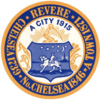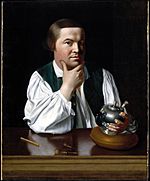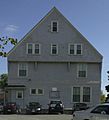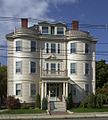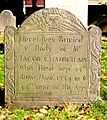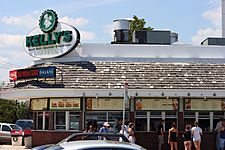Revere, Massachusetts facts for kids
Quick facts for kids
Revere, Massachusetts
|
||
|---|---|---|
|
City
|
||
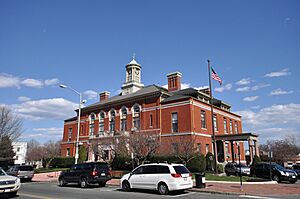
City Hall
|
||
|
||
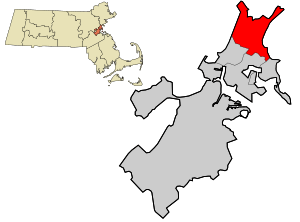
Location in Suffolk County and the state of Massachusetts
|
||
| Country | United States | |
| State | Massachusetts | |
| County | Suffolk | |
| Settled | 1630 | |
| Incorporated | March 19, 1846 | |
| Name Change | March 24, 1871 | |
| City | November 3, 1914 | |
| Government | ||
| • Type | Mayor–Council | |
| Area | ||
| • Total | 10.13 sq mi (26.24 km2) | |
| • Land | 5.70 sq mi (14.77 km2) | |
| • Water | 4.43 sq mi (11.47 km2) | |
| Elevation | 20 ft (6 m) | |
| Population
(2020)
|
||
| • Total | 62,186 | |
| • Density | 10,902.17/sq mi (4,209.46/km2) | |
| Time zone | UTC−5 (Eastern) | |
| • Summer (DST) | UTC−4 (Eastern) | |
| ZIP code |
02151
|
|
| Area code(s) | 339 / 781 | |
| FIPS code | 25-56585 | |
| GNIS feature ID | 0612810 | |
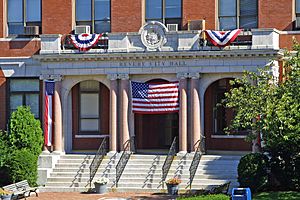
Revere is a city in Suffolk County, Massachusetts, about 5 miles (8 km) from downtown Boston. It was first called North Chelsea when it was founded in 1846. In 1871, its name changed to Revere, honoring Paul Revere, a hero from the American Revolution. The town officially became a city on January 4, 1915, when its first mayor took office. In 2020, about 62,186 people lived in Revere.
Contents
Exploring Revere's Location
Revere is located on the coast of Massachusetts. It shares borders with several other towns and parts of Boston. To the south, you'll find Winthrop, Chelsea, and East Boston. To the west are Everett and Malden. To the north, Revere borders Saugus and Lynn. The Atlantic Ocean is to the east.
The city covers about 10 square miles (26 square kilometers). A little more than half of this area is land, and the rest is water.
Revere's Neighborhoods
Revere has many different neighborhoods, each with its own unique feel.
Beachmont
Beachmont is the easternmost part of Revere. It sits between Revere Beach Boulevard and East Boston's Orient Heights. This area has many different cultures and a mix of homes and businesses.
Broadway
Broadway is the main street in Revere. It's a busy area with shops, homes, and public buildings like Revere City Hall. It's a key route for getting around the city and to nearby towns.
Oak Island
Oak Island is close to the Point of Pines and the end of Revere Beach. It mainly has single and multi-family homes. This neighborhood is next to Revere's marsh and wetlands.
Point of Pines
Located at the very end of Revere Beach, Point of Pines is mostly made up of homes. People living here can enjoy their own private part of Revere Beach.
Revere Beach Boulevard
This road runs right along Revere Beach. It features apartments, restaurants, and homes. New buildings have brought fancy apartments and nice restaurants to this area.
Revere Street
Revere Street connects Broadway to Revere Beach. It's a busy road for people traveling across the city. You'll find many local businesses, restaurants, and stores here.
Shirley Avenue
The Shirley Avenue neighborhood has a long history of welcoming new people to Revere. Over the years, it has been home to Jewish, European, Latin American, African, and Cambodian communities. It's the most diverse part of the city, with many ethnic grocery stores and restaurants.
West Revere
West Revere mostly has single and multi-family homes. It also has the Squire Road business district. This area includes large shopping centers, restaurants, and hotels.
Revere's Past: A Look at History
The first people to live in Revere were Native Americans from the Pawtucket tribe, known as the Rumney Marsh Indians. Their leader was Nanepashemet. In the early 1600s, a terrible sickness, likely smallpox, spread through the area, causing many deaths.
Native Americans often helped the early European settlers learn about the land. During King Philip's War, some friendly Native Americans were moved to Deer Island. Many of them died there, but some also helped the colonists fight other tribes.
Rumney Marsh was first divided among 21 important citizens from Boston. By 1639, it became seven large farms. Farming was the main activity. In 1634, Rumney Marsh became part of Boston. The first major road in North America, built in 1641, crossed Rumney Marsh.
In 1739, Rumney Marsh, Winnisemmet, and Pullen Poynt separated from Boston to form the town of Chelsea. Rumney Marsh, which was the largest, became the town center.
In 1775, the area was important in the American Revolution. The first naval battle of the war happened near Rumney Marsh.
In 1852, Pullen Poynt became the town of Winthrop. In 1871, North Chelsea changed its name to Revere, honoring Paul Revere, who had passed away in 1818.
On July 28, 2014, a strong tornado hit nearby Chelsea and then Revere. It caused a lot of damage to buildings, including Revere City Hall. Cars were damaged, and there were power outages and fallen trees. This was the first tornado to hit Suffolk County since records began in 1950.
Who Lives in Revere?
| Historical population | ||
|---|---|---|
| Year | Pop. | ±% |
| 1850 | 935 | — |
| 1860 | 921 | −1.5% |
| 1870 | 1,197 | +30.0% |
| 1880 | 2,263 | +89.1% |
| 1890 | 5,668 | +150.5% |
| 1900 | 10,395 | +83.4% |
| 1910 | 18,219 | +75.3% |
| 1920 | 28,823 | +58.2% |
| 1930 | 35,680 | +23.8% |
| 1940 | 34,405 | −3.6% |
| 1950 | 36,763 | +6.9% |
| 1960 | 40,080 | +9.0% |
| 1970 | 43,159 | +7.7% |
| 1980 | 42,423 | −1.7% |
| 1990 | 42,786 | +0.9% |
| 2000 | 47,283 | +10.5% |
| 2010 | 51,755 | +9.5% |
| 2020 | 62,186 | +20.2% |
| 2022* | 58,528 | −5.9% |
| * = population estimate. Source: United States Census records and Population Estimates Program data. Source: |
||
In 2019, about 53,692 people lived in Revere. The city is very diverse. Many people are White, Black, Asian, or Native American. A large part of the population is also of Hispanic or Latino background, including people from El Salvador, Colombia, Puerto Rico, and other countries. Revere also has a notable Italian American population.
Revere is a growing city. After the 2020 census, it was found to be the fastest-growing city in Massachusetts.
Revere's Weather
In Revere, temperatures usually range from about 23°F (–5°C) in winter to 82°F (28°C) in summer. It rarely gets colder than 9°F (–13°C) or hotter than 91°F (33°C).
Rainfall is pretty steady throughout the year. October is usually the wettest month, and January is the driest. Snow typically falls from November to April, with January seeing the most snow.
The air can feel humid, or "muggy," for about three months, from June to September. July has the most muggy days.
People from Around the World: Immigrant History
Revere has a rich history of welcoming people from many different countries.
Early Immigration (1600s–1800s)
In the early days, Massachusetts wanted to keep its colony Puritan. They also worried about people who couldn't support themselves. So, laws were made to control who could move there. English immigration slowed down after 1642 due to the English Civil War.
By 1687, only 31 people lived in the settlements that would become Revere, Chelsea, and Winthrop. By 1739, when Chelsea was formed, there were 267 people. This number grew a lot by 1837, reaching 1,201 people.
The Rumney Marsh Burying Ground in Revere has graves of 16 formerly enslaved Black people. A plaque there lists their names and ages.
Second Wave of Immigration
Between 1837 and 1840, Revere's population almost doubled. This was due to a big wave of immigrants coming to America. Over 750,000 Irish, British, and German immigrants arrived. Many Irish people came to escape poverty and famine in their home country.
Third Wave of Immigration
By 1905, many Italian people had moved to Revere. The first Italian Catholic church, Saint Anthony of Padua, was founded that year. At this time, most immigrants to the U.S. were from southern, eastern, and central Europe. In Revere, nearly 60% of babies born had parents who were born in other countries.
Jewish Immigration
The first Jewish residents in Revere were from Russia and Poland. Their numbers grew from 137 in 1885 to 1,646 by 1915.
Revere's first Jewish congregation, Temple B’Nai Israel, started in 1906. By 1940, Jewish residents made up about 25% of Revere's population. Shirley Avenue was a lively center for Jewish life, with businesses, synagogues, and markets.
21st Century Immigration
In 2010, 27% of Revere's residents were born outside the United States. Many came from North Africa, Asia, Europe, and Latin America. This was twice the number from 1990.
Revere also has a large Moroccan community. In 2017, the city held its first Moroccan Cultural Day. During the coronavirus pandemic, a group called "Moroccan American Connections in Revere" (MACIR) helped the city by providing handmade masks.
Revere's Economy
Revere is working to grow its economy. In 2018, the city launched a plan called 'Next Stop, Revere'. This plan aims to improve the city over the next 10-20 years. It focuses on helping people find jobs, supporting small businesses, and attracting new industries like science and technology.
Top Employers in Revere
Here are some of the biggest employers in Revere:
| # | Name | Nature of Business | # of Employees |
|---|---|---|---|
| 1 | Market Basket | Supermarket | 210 |
| 2 | Mass General Hospital | Medical | 200 |
| 3 | Price Rite | Supermarket | 183 |
| 4 | Lighthouse Nursing | Nursing | 182 |
| 5 | Target | Retail | 170 |
| 6 | Stop & Shop (Squire Road) | Supermarket | 150 |
| 7 | Annemark Nursing (closed 2021) | Nursing Home | 135 |
| 8 | Showcase Cinema (closed 2020) | Cinemas | 103 |
| 9 | OceanAir | Shipping/Logistics | 100 |
Places to See in Revere
Nature and Parks
Revere Beach

Revere Beach is special because it's the oldest public beach in the United States. It has a lively area along the beachfront. For a long time, it was a popular spot for working-class families and immigrants. The beach area is so important that it's listed on the National Register of Historic Places.
In the 1950s, the beach started to decline. Then, the Great Blizzard of 1978 caused a lot of damage. Many businesses, rides, and parts of the seawall were destroyed.
In the past, Revere Beach had many fun amusement rides and attractions. There were rides like The Whip, the Ferris wheel, and the famous Cyclone roller coaster. The Cyclone was built in 1925 and was one of the biggest roller coasters in the U.S. It reached speeds of up to 50 mph (80 km/h) and was 100 feet (30 m) tall. There were also roller skating rinks, bowling alleys, and dance halls.
The beach was greatly improved in the 1980s and officially reopened in 1992. Now, it has new housing, a re-sanded beach, and restored buildings. Revere celebrated 100 years of Revere Beach in 1996.
Rumney Marsh Reservation
The Rumney Marsh is a Massachusetts state park. It covers 600 acres (2.4 km²) in Revere and the town of Saugus.
Historic Sites
National Register of Historic Places
Revere has eight places listed on the National Register of Historic Places. These are important sites recognized for their history.
-
Revere Beach Reservation
-
Revere Beach Reservation Historic District
Other Interesting Historic Places
Kelly's Roast Beef
Kelly's Roast Beef is a famous fast-food place that started in Revere in 1951. Its main restaurant is on Revere Beach. Kelly's says they invented the modern roast beef sandwich.
Necco Factory
The Necco candy company was once the oldest candy company in the U.S. It was known for Necco Wafers and Sweethearts Conversation Hearts. The company had its main office in Revere until it closed in 2018.
Revere Post Office
From 1934 to 1943, artists painted murals in U.S. Post Offices to cheer people up during the Great Depression. In 1939, artist Ross Moffett painted a mural called The First Store and Tavern in the Revere Post Office.
Revere Public Library
The Revere Public Library is a Carnegie library, built in 1903. It's special because it has never been expanded, so its original beautiful architecture is still visible.
Slade Spice Mill
Slade Spice Mill is an old mill that played a small part in the Revolutionary War. Later, it became the home of the D & L Slade Spice Company, which grew to be the biggest spice company in New England.
St. Anthony's of Padua
St. Anthony's was Revere's first Italian church. The first church was built in 1906. A larger church was built in 1924, and its current building was finished in 1943.
Wonderland Greyhound Park
Wonderland Greyhound Park was a greyhound racing track in Revere. It opened in 1935 on the site of a former amusement park. Greyhound racing happened there until 2009, when it was banned in Massachusetts. The future of the land is still being decided.
Getting Around Revere
The arrival of railroads in the 1800s helped Revere grow quickly. The Eastern Railroad came in 1838, and the Boston, Revere Beach & Lynn Railroad in 1875. This led to a big increase in population and made the beach a popular summer spot.
In 1871, Revere was the site of The Great Revere Train Wreck of 1871. This was the deadliest train accident in Massachusetts history at that time.
Today, the MBTA Blue Line subway has three stops in Revere: Wonderland, Revere Beach, and Beachmont.
Several major roads also run through Revere, including U.S. Route 1 and state highways 1A, 16, 60, 107, and 145.
Learning in Revere
Revere Public Schools manages the public schools in the city. High school students can attend Revere High School, Northeast Metropolitan Regional Vocational High School, or the Seacoast School. Some students also go to charter schools in other cities.
There are three public middle schools: the Garfield School, Susan B. Anthony Middle School, and the Rumney Marsh Academy. For younger students, private schools include Eagle Heights Academy and Immaculate Conception.
Famous People from Revere
Many notable people have connections to Revere, including:
- Horatio Alger Jr., author
- Elliot Aronson, psychologist
- Elizabeth Bishop, poet
- John Cazale, actor
- Billy Conigliaro, professional baseball player
- Tony Conigliaro, professional baseball player
- Glenn Danzig, singer-songwriter
- Bill Macy, actor
- Roland Merullo, author
- Zack Norman, actor
Sister City
In 2016, Revere signed a sister city agreement with Date City, Fukushima in Japan.
See also
 In Spanish: Revere (Massachusetts) para niños
In Spanish: Revere (Massachusetts) para niños


